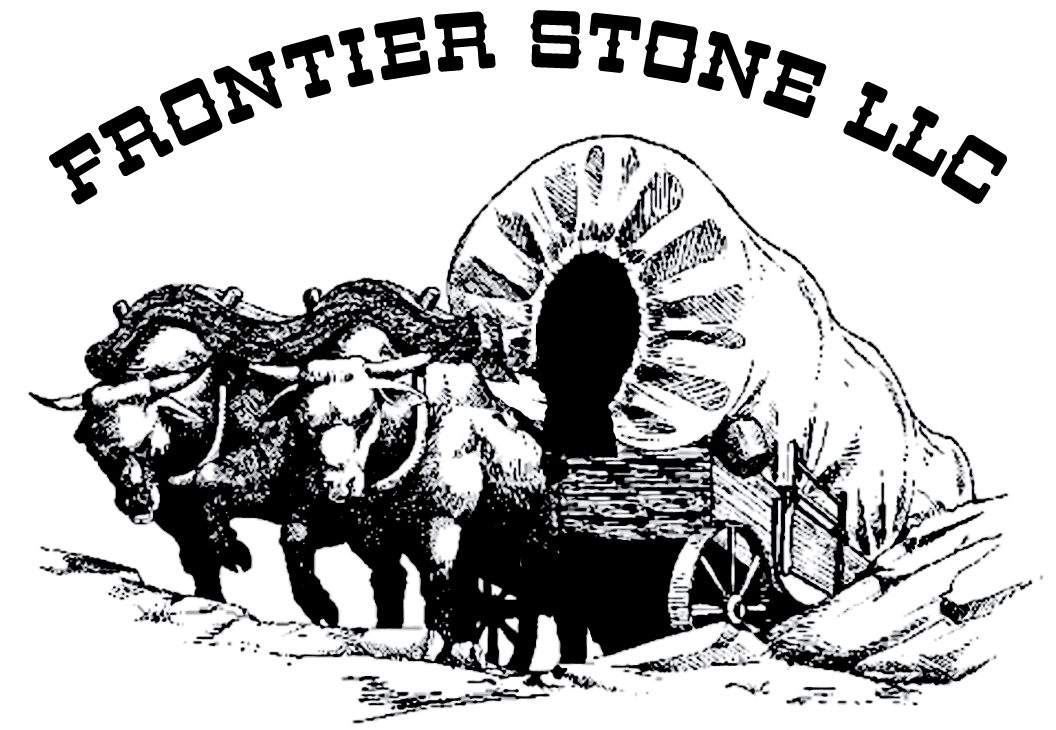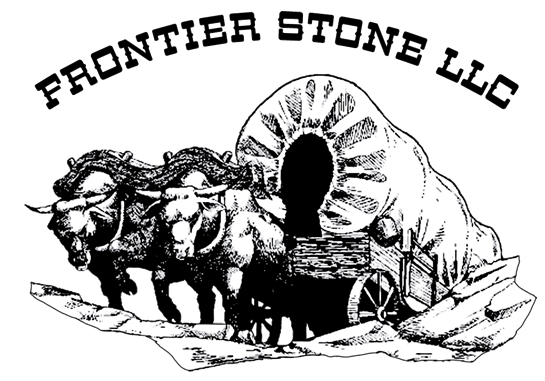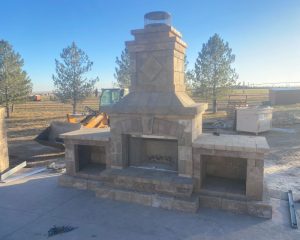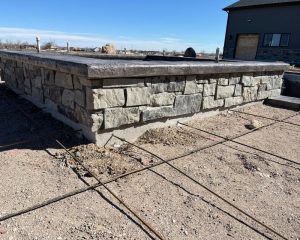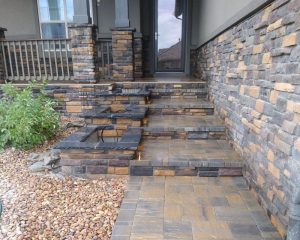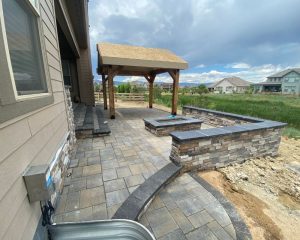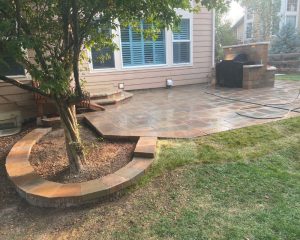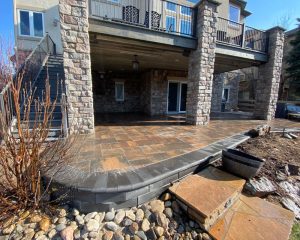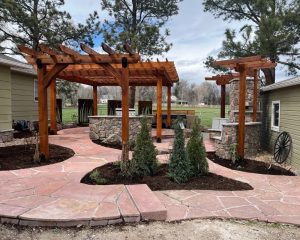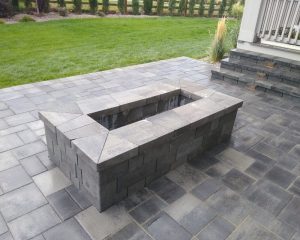Construction Of New Segmental Retaining Walls
At Frontier Stone, we are experts in constructing exceptional segmental retaining walls. The advantages of choosing segmental retaining walls are numerous and contribute to an outstanding outdoor space. These walls not only provide aesthetic appeal but also offer design flexibility, cost-effectiveness, ease of installation, and remarkable durability.
One of the significant benefits of segmental retaining walls is their aesthetic appeal. We understand the importance of creating a visually pleasing environment, and segmental walls provide a harmonious blend of functionality and beauty. With a wide range of design options available, we can customize the wall to complement your landscape.
Flexibility in design is another key advantage of segmental retaining walls. We work closely with you to understand your vision and design preferences. Whether you desire a contemporary look or a timeless charm, segmental walls offer the flexibility to create the perfect style that aligns with your unique taste.
In addition to their visual appeal and design versatility, segmental retaining walls offer economic advantages. These walls are cost-effective compared to other options while providing excellent structural integrity. With Frontier Stone, you can have a durable and long-lasting retaining wall without compromising your budget.
The ease of installation is another standout feature of segmental retaining walls. As pre-engineered systems, they streamline the construction process. This means that the wall can be built according to your project specifications without the need for extensive architectural or engineering designs. Our team can construct the wall to meet engineering requirements, ensuring compliance and safety. If necessary, we can also involve a qualified engineer to review and approve the project, especially for walls with specific height or size considerations.
Retaining Walls & Building Permits in Boulder County and Weld County, Colorado
For retaining walls in Weld County and Boulder County, specific regulations apply to ensure structural integrity and safety. Retaining walls that are under 3 feet in height can be built without a permit or any engineering requirements. Retaining walls that exceed a total height of 3 feet (measured from the top of the wall to the bottom of the footer) or are situated on slopes with a gradient of 15 percent or greater must be designed by a licensed engineer in the state of Colorado. This requirement ensures that these critical structures meet engineering standards and considerations.
At Frontier Stone, we are very familiar with the retaining wall requirements in both Weld County and Boulder County and we'll be able to ensure your wall is built to meet or exceed any of their building requirements.
Proper Drainage For Retaining Walls
At Frontier Stone, we frequently receive inquiries from potential customers who are facing issues with their existing retaining walls. Whether it's a wall that is falling down, bulging, or collapsing, one of the most common causes of retaining wall failure is poor drainage.
Retaining walls are designed not only to withstand the pressure of earth and soil but also to effectively manage water flow. When water accumulates behind a retaining wall, it creates what industry professionals refer to as "hydrostatic pressure." This external force, combined with the weight of the water, can significantly compromise the structural integrity of the wall, leading to failures such as bulging or even complete collapse.
To ensure the long-term durability of a retaining wall, proper drainage is of utmost importance. A well-built retaining wall must incorporate effective drainage systems to mitigate hydrostatic pressure. Depending on the type of material used for the wall, there are various drainage solutions available. These can include lateral drains, French drains, weeping drains, blanket drains, and the use of granular soil or fill behind the wall to disperse rather than retain water.
By integrating appropriate drainage measures, a retaining wall can withstand the test of time. It allows water to flow away from the wall, preventing the build-up of hydrostatic pressure that can compromise its stability. Our team at Frontier Stone is well-versed in the importance of proper drainage in retaining wall construction. We employ best practices and industry expertise to ensure that your retaining wall not only functions flawlessly but also remains structurally sound for many years to come.
When it comes to retaining wall projects, don't overlook the significance of drainage. Partner with Frontier Stone, and let us design and construct a retaining wall that incorporates efficient drainage systems tailored to your specific needs. Our commitment to quality craftsmanship and attention to detail ensures that your retaining wall will stand strong, even in the face of hydrostatic pressure challenges.
Understanding Retaining Wall Surcharges
In the realm of retaining walls, the term "surcharge" refers to the additional weight exerted on or behind the wall. When constructing a retaining wall to accommodate a specific purpose, such as creating a parking area for a boat or an RV, it becomes crucial to consider the weight of these vehicles and their impact on the structure.
For a retaining wall to withstand the presence of a surcharge, it must be built with this factor in mind. This consideration extends to tiered retaining walls, those designed to support a fence or any other weight beyond the soil it is intended to hold back.
To reinforce the structural integrity of a retaining wall and ensure its long-lasting performance, geo-grid is commonly employed. Geo-grid is a material that provides additional tensile strength to each course of the wall, anchoring it to the ground behind. By utilizing geo-grid properly, your retaining wall gains the necessary reinforcement to withstand the excess weight and prevent collapse or buckling.
At Frontier Stone, we understand the critical role of surcharge and the significance of proper reinforcement in retaining wall construction. Our expert team incorporates geo-grid as a key component to fortify the structural stability of your retaining wall. By implementing this technique, we ensure that your wall is built to last, even under the additional weight exerted by surcharges.
When planning your retaining wall project, whether it involves accommodating vehicles or incorporating other forms of weight, Frontier Stone has the expertise to create a durable and reliable structure. Trust us to construct a retaining wall that not only fulfills its intended purpose but also stands strong for years to come.
What Materials Do We Use For Retaining Walls?
There are many different materials to build your retaining wall out of. Below are some of the more popular materials in our area because of their availability.
- Block retaining walls
- Natural stone retaining walls
- Large boulder retaining walls
How Our Retaining Wall Construction Process Works
When building a retaining wall on your property that is designed to hold back soil and earth from erosion there is very little margin for error so when required we work directly with engineers if your wall is over 6 feet in height. There are many pre-engineered systems we can use as well that can eliminate the need for detailed building plans.
- We start with our initial consultation.
- We determine how many feet of retaining wall you need.
- We determine the height of the wall and if a building permit or engineer will be required.
- We take into account any surcharges (weight) the wall might be exposed to.
- We consult with you on the materials you’d like your retaining built with.
- We’ll provide you with an accurate written estimate for the work.
The amount of work required to build a retaining wall can vary widely from project to project. The slope of your property, the amount of earth your retaining wall must hold back and the overall accessibility of your property will all contribute to the final cost. We’ll be able to offer you an accurate estimate only after a site visit.
